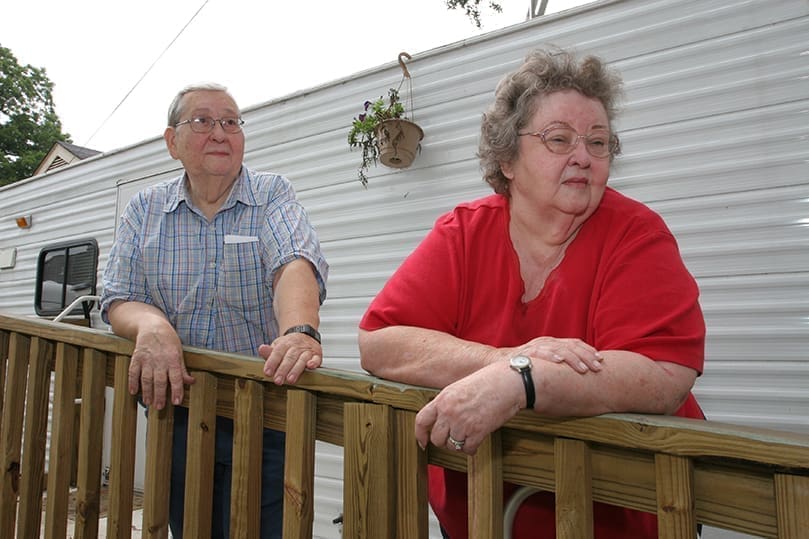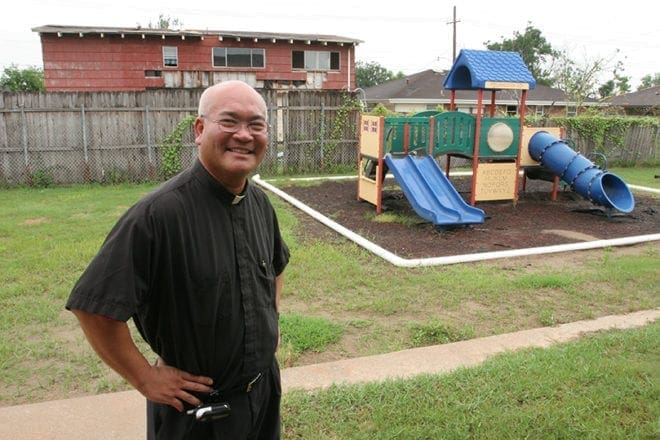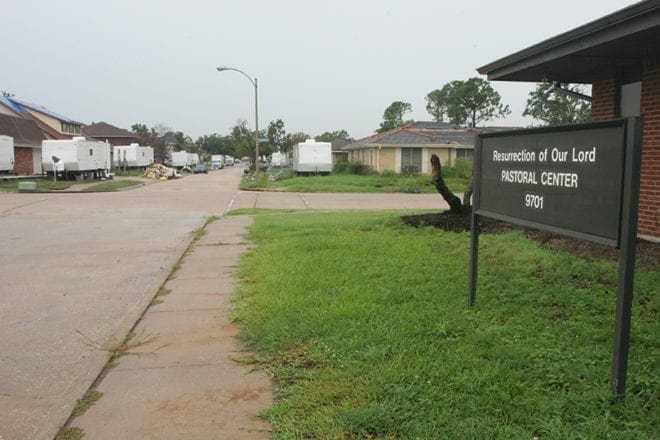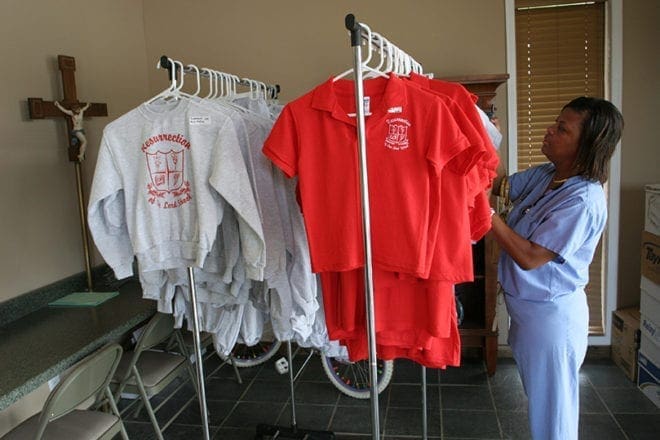 Photo By Michael Alexander
Photo By Michael AlexanderNew Orleans
New Orleans Parish Finds ‘Our Faith In Misery’
By PRISCILLA GREEAR, Staff Writer | Published September 14, 2006
Steven Madere drives 30 miles daily from the house he bought following Hurricane Katrina to Resurrection of Our Lord Church and School to assist Father Michael Joseph Vinh Nguyen as a volunteer in cleaning up, painting, landscaping and coordinating volunteers from across the nation as they help to rebuild nine parish buildings.
Madere had had a bad feeling before Hurricane Katrina hit. On the Friday before the storm he made reservations at a motel in Houston, evacuating at 6 a.m. Sunday in a Dodge van with his parents and other family to Texas, and then driving to northern Louisiana. Once back in New Orleans the recent retiree secured a fair insurance settlement on his damaged home. Having recently ended his 25-year job at the Health Sciences Center at Louisiana State University, Madere was preparing to pursue interests in writing and photography. While he mused that this year following Katrina may give him something to write about, he realizes that God has other plans.
“I have a new truck, new house and lots of new possessions. God took care (of me) and turned it into a blessing for me, and I have to return the blessing. … When Father Michael got ahold of me it was just something I couldn’t refuse. It kept growing and growing.”
Madere is one of several hundred volunteers from around the nation, including a corps of nearly 100 men from St. Peter Chanel Church in Roswell, who have participated in the rebuilding of this East New Orleans Catholic community. And pastor Father Nguyen and school principal Dr. Si Nguyen are deeply grateful.
Father Nguyen returned last Oct. 5 following Katrina to Resurrection of Our Lord, which had undergone extensive renovations before the storm. He discovered the campus buildings sat in five to seven feet of water and that everything was soaked from pews to filing cabinets to books. But this soft-spoken priest, who grew up in Vietnam and fled by boat as a refugee as a youth, was undaunted and knew what his new mission would be—to restore the buildings and soul of his beloved multicultural community, which numbered about 1,700 families before Hurricane Katrina. The storm took the lives of seven senior parishioners.
The parish’s first weekly Mass was on Easter, and as the community carries on they are now encouraged to have over 325 people attending the three weekend Masses offered in this devastated area of the city. They also had a robust six-week summer camp for 145 children and their parents, complete with hay rides, horseback riding and water slides, plus math, reading and science activities. The camp was held Aug. 11 in their refurbished school, which opened this fall with 288 students and a waiting list. Three other Catholic schools of East New Orleans have closed, so Resurrection is serving as a central school, taking in their students as well. Father Nguyen believes that the church’s steadfast presence following the storm has been a source of solace and strength.
“I believe it’s become a very positive sign for the New Orleans area. It’s important for the life of the Catholic Church to be present and to be a sign of hope for the people and to provide leadership,” said the priest, who earned degrees from the Urbanianum, Angelicum, Gregorianum and the Marianum in Rome and has a framed picture of himself with Pope John Paul II that he salvaged.
“With all of this they recognize our faith in the misery. The resurrection of Christ, his life, his suffering, his death and especially his resurrection—that’s our hope. That’s the main motivation for what we’re doing here at Resurrection.”

In the damaged home of John and Betty Browne, a souvenir rosary from the 1984 World’s Fair in New Orleans can be found on the floor among dry wall and other debris. Photo By Michael Alexander
Living out of another rectory in an area in the first months after the storm, Father Nguyen returned daily to the site in the middle-class neighborhood of ranch homes with collapsed roofs and strewn debris. He first began, along with the principal and maintenance worker Sang Hoang, to clear all the debris from the church, school and parish center buildings. They left by sunset each day until February, all the time working without electricity. Father Nguyen’s brother, Father Dung Nguyen, serves in the Atlanta Archdiocese through which Father Michael Joseph made a plea for help right after the storm at St. Peter Chanel Church in Roswell. One November weekend nearly 100 men from the parish answered the call and rode overnight on a bus to Resurrection. In just one day the work boot-clad men quickly hauled out doors and hacked at sheetrock walls to leave only the stud wood and steel frames, amidst dust, fiberglass and mold. They gutted nine buildings. Other faith groups ranging from Mormons to Protestants followed suit in coming months, supplementing the work of paid contractors. By February the pastoral center was repaired with new sheetrock and paint, and by March Father Nguyen was able to move to the newly repaired rectory. Groups of college students from Michigan and Ohio spent their spring break volunteering there, as “they just heard about us and wanted to come down and help.” Some 179 young adult and other volunteers from outside Louisiana leveled dozens of loads of sand, painted the church, cafeteria, and walkway around the school and gutted parishioners’ houses in severe heat and rain to prepare for the summer camp. In late June Dominican nuns and laypersons from Kansas and Kentucky scraped, primed and painted the interior of the newly repaired cafeteria. Parishioners Mary and Joe Perez prepared meals including jambalaya and boiled shrimp for volunteers.
Wearing a T-shirt showing children dangling from gym bars that promoted the summer camp, Father Nguyen recalled in an interview in the pastoral center July 23 how the camp enlivened the entire community.
“We were so glad to see the children. They bring so much joy and inspiration from their presence. They were so happy, and we’re blessed that they came and the parents, we felt like we were doing something for them. They could leave their children here and went on to go to work,” he said. “The last 11 months of undaunted and tireless work have paid off. If I had to start again, I would without a second thought. The children can bring so much life and hope and joy to the community.”
The principal Dr. Nguyen said about half their students are new this year and that most still live in Federal Emergency Management Agency trailers. He said that while a lot of rebuilding came through volunteers they worked through the archdiocese to have mold treatments and other work to ensure buildings meet safety codes. They received school money through a government Restart grant, from the archdiocese and from donor support from various other sources, including a donation of 48 computers from Best Buy. He said the school theme for teachers this year is surviving and excelling.
Parents realize that “we’re adapting and overcoming obstacles to provide as much of a normal environment for the kids, and they’re responding well. Both the faculty and staff really stepped up in the last several weeks to get the school ready and prepared and making adjustments to make sure the students receive the best education possible.”
Still, the majority of houses remain unoccupied in the surrounding neighborhood with boarded-up gas stations and businesses and hand-written signs advertising contracting work, retaining the somberly subdued feel of a disaster zone. Some residents return to their homes during the day to repair them, but there are no banks or hospitals in the area, and gas stations and strip mall businesses are boarded up. The pastor drives to another town to shop at the nearest grocery store.
In an August progress report to his parish, the pastor wrote, “My surrounding neighbors have no power, no gas, no services, no bank, no grocery, no hospital. … Sadly, the vast majority of homes have not been touched. … They continue to wait for some direction from the state and the city.” A billboard nearby quotes from 1 Peter, “Cast all your anxiety on (God) because he cares for you.”
The church still needs new tile flooring and an air conditioning system for a targeted move-in month of November. The cafeteria is now ready with a new ceramic tile floor and air conditioning. The kitchen, however, still needs restoration. The preschool building is like a skeleton with wood beams where walls once stood to separate rooms. They have been given approval by the archdiocese to begin restoring that and the middle school building, which will house the science and computer labs, library and 10 classrooms. For now they’re using the one restored building with new walls, floors and ceilings and desks set up for its 12 classrooms. Father Nguyen peeked into one classroom filled with new black computers, noting how the original wall had collapsed, and then entered an office with racks of red and khaki school uniforms. The remaining school renovations will cost an estimated $4.9 million.
Prior to Katrina, the archdiocese, which covers eight civil parishes, boasted 107 elementary and secondary schools with a total student population of 50,000, according to Superintendent of Schools Father William Maestri. Now 40,000 students attend the 84 schools that have reopened, he said.
The morning of July 23, black, white and Asian worshippers filled the two Sunday morning Masses held in the pastoral center, which was completed in the second week of February and has been used as the school and parish offices, general meeting place and chapel for daily and weekend Masses. Since then weekend Mass was moved to the cafeteria.
“The good news is we have 12 beautiful classrooms,” the pastor announced to congregants.
Prayers were made to Our Lady of Prompt Succor “that we be spared any damage in this hurricane season.” The pastoral center, which is now being used for preschool space, has cushioned chairs, new tiles, ceiling fans and beige walls adorned with pictures of a dark-skinned Jesus and Our Lady of Guadalupe.

Father Michael Joseph Nguyen, pastor of Resurrection of Our Lord Church, New Orleans, stands outside the parish school, which will serve as the central Catholic school for the area. Photo By Michael Alexander
Those at Mass described various stages of personal recovery and rebirth and how their spiritual foundation sustained them through the deluge. Ivan and Liz Gatzman and their daughter, Allison, a student at Louisiana State University, described how they had purchased a new house before the storm and had not yet sold the old one, both of which were flooded, destroying everything except pictures on the walls. They prayed every year to Our Lady of Prompt Succor in the hurricane season and had thought the Saturday before Katrina that it was just another storm where “everybody freaks out and nothing happens,” said Allison—until they saw long gas station lines. By Sunday morning Mr. and Mrs. Gatzman knew they had to evacuate, joining Allison in Baton Rouge. In those early weeks “you heard so much that you didn’t know what to believe. You heard some reports that the French Quarter was underwater and that’s the place that got nothing,” noted Allison.
When they first returned “it was like a war zone,” said Mrs. Gatzman.
“At first it was very, very difficult. We didn’t know if we’d have jobs, and there was not much money in the bank,” Mr. Gatzman said.
Mrs. Gatzman recalled busting through the front door of their new house to find evidence that their furniture had floated around in three feet of water. “It was a shock, with the new house. … You couldn’t break down because your neighbor was the same way. You couldn’t feel sorry for yourself. You just gathered your strength and moved forward.”
They attended that first Mass at Resurrection along with the men who had come to help from Roswell. The pews were gone, the floor was bare, and there were no lights or power. Only the altar, tabernacle, ambo and high altar remained. The sun was setting, and the cavernous interior of the church began to grow dim. Two candles on the altar flickered. Father Nguyen alluded to the days when early Christians gathered in the catacombs for worship and prayer.
“At Mass there was not a dry eye in the house—100 men we didn’t know” coming to help was remarkable, Mrs. Gatzman said. “It’s been a blessing to come here. We have this intimate setting. It’s so comforting to see a familiar face. … Father Michael, he can just speak and get things going. … That’s the one thing you do just have, your faith, to get you through something like this. It’s so devastating that that’s all you can do.”
But things are looking up. The Gatzmans received enough insurance money to restore their new home, which is located in a subdivision where many families have already repaired the houses and returned. They’re living there now and are repairing the old house. Businesses have begun to reopen around them, yet they feel the media ignores this entire area, which “is kind of like the stepchild of New Orleans,” said Allison.
A real estate agent, Liz reported that where she works in uptown “it’s a boom—investors are coming in and buying,” as people are looking for good deals on homes that before the storm they might have not been able to afford.
They’re trying to not dwell on the uncertainty as they return to normalcy.
“I feel confident that if it’s a category 3 or less we’ll be OK, but anything like Katrina will just wipe us out. A lot of people are really scared, but the last time something like Katrina hit was in the ‘60s,” added Allison, who in high school taught religious education at Resurrection. “You can’t live in fear from year to year.”

FEMA trailers of the residents who have returned to the neighborhood can be seen from the pastoral center at Resurrection of Our Lord Church, New Orleans. Photo By Michael Alexander
Allison noted that she managed to have her best semester at school, pouring her stress into her studies. “I don’t know if that was my outlet and I put more (effort into school.)”
Shirley Chatters, who was attending Mass with her sister, was more deeply scathed financially by Katrina. She and her husband left behind their clothing boutique in East New Orleans and evacuated to join family in Minneapolis. She doubts she’ll return to the home she lived in for 30 years but is waiting to see how restoration efforts progress.
“This is home. That’s why we want to hold onto the house because we have lots of friends, even though all our friends are scattered as we are. There’s an uncertainty about the city and the levees … and how soon the city will be rebuilt.”
She received money from her flood insurance but not her homeowners insurance, which refuses to pay because the company alleges that there wasn’t any wind damage even though roof tiles were damaged. She didn’t have any flood insurance on her boutique because it wasn’t in a flood zone, and “we lost thousands of dollars in merchandise, which I still owe my creditors.”
Chatters, 67, has applied for a loan from the Small Business Association and registered with the state for a homeowners restoration grant but hasn’t received any money yet. She has received calls “around the clock” from companies for not paying bills following the storm, and many have reported her to credit bureaus.
“They’re making it very difficult to buy anything on credit. … Now all of a sudden we look like irresponsible people. … It’s not your fault it happened,” she said. Nevertheless, she is resilent. “I don’t buckle, and I’m a fighter. I’m willing to fight back if I feel I’m being wronged.”
A native of New Orleans and a Loyola University graduate, John Browne, 75, volunteers as an altar server, lector and eucharistic minister at Resurrection at weekend Masses and was back at church Tuesday morning July 25 to assist Father Nguyen, with whom he enjoyed some lemon poundcake made by a parishioner for breakfast. He and his wife, Betty, were driven out of their nearby home of 40 years. They had already been planning before the storm to move into a vacant house that has been in his wife’s family but had procrastinated. Their home was gutted by a Baptist seminarian and ministry volunteers, who, when driving by, saw the wooden handicap ramp on their FEMA trailer and offered to help.
“We said, does it include gutting our house in East New Orleans?”
Browne drove by their old brick house, where most of the mildewed items remain, even their clothing hanging in the closet, medicines in a collapsed cabinet and utensils hanging in the kitchen cupboard. Trash was stuffed in the toilets and scattered everywhere. Amidst the debris he pointed to an olivewood rosary from Jerusalem and a wood rocker that had been in his wife’s family for 100 years. Across the street is a shriveled grey palm tree and spray-painted on their house is a 0, indicating that no dead bodies were found there after the storm.
He then drove a couple of miles away to the Gentilly Terrace neighborhood where they are living in a FEMA trailer while restoring the vacant family home, which recently got new kitchen cabinets, new sheetrock for the walls throughout and crown molding. This neighborhood is more lively with semi-restored houses and signs like “we’re home—bring New Orleans back.” Some houses have yard signs from Catholic Charities, indicating they’ve been gutted through a program to help seniors, the disabled and others. Browne jokingly calls their trailer an “efficiency apartment” with a sofa bed, a restroom with folding doors, a kitchen with an electric stove and oven, freezer and microwave. Their yard is shaded by the gnarled branches of a live oak and a hot pink crape myrtle and guarded by their English setter/Springer spaniel named Tex.
“It’s something we had procrastinated on for five years, and Katrina gave us that push, and we didn’t have to move all that stuff we accumulated. (My wife) said ‘you’re just like a man—to me it’s memories,’” said Browne. “We feel very safe with Tex in the trailer. … Three blocks have street lights, we have all city services, we recently got mail services.”

Registered nurse Shelia Mathieu shops for uniforms at Resurrection of Our Lord Church the last week in July. Her two daughters are 5th and 7th graders at the parish school this year. Mathieu’s family lived in Houston for four months following Hurricane Katrina before returning to New Orleans. Photo By Michael Alexander
His wife was more fatigued from the ordeal as she came out of the trailer with her walker and a bag reading, “The Lord is my Shepherd” tied to it, and recalled everything they lost with sentimental value.
“When it happened, I thought it was a terrible nightmare, and I was going to wake up and it would all be gone, and it never was,” she recalled. “Women have more strong attachment to things than men, baby pictures of our son, things mother had left me, my parents. I guess it’s all things, but still it’s important to me. It’s a shame to see the city the way it looks. It was such a beautiful city. It’s a slow process. The Lord knows what he’s doing, but we often wonder why,” she said, adding that their son went to grade school at Resurrection and that they coordinated the parish lectors for years.
Mr. Browne feels that church attendance has been one way to fortify their faith.
“We demonstrate our faith by coming to church regularly. In the mornings I don’t work. I’m here for 8:30 a.m. Mass. I think our faith has seen us through this,” he affirmed. “It has not made us bitter. It has made us hopeful that we’ll survive with God’s help.”
Madere is also hopeful and noted that he made friends with the couple to whom he sold his old home at low cost and has purchased a new home with his parents in Norco. His father travels to Martinsville, where their daughter lives, for his cancer treatment due to still limited health care in New Orleans. He also has given tours to volunteers and takes them to the French Quarter while explaining the history of the region, and answering their many questions about Katrina.
“That’s always fun to tell people about where you live,” said the native. He always tells them about what he sees as the miracle amidst the devastation in how God opened many hearts and homes and political bodies across the nation. “That’s the way you have to look at it.”
Madere, who before the storm was vice president of the men’s club and a parish council member, is eager to help with the next phase of school renovation, and is pleased that Mass “attendance has been going up every week.”
He just got an e-mail from a local company whose volunteer group wants to help with grounds beautification, which is important as the eight-acre property lost about half of its trees and all its gardens and yard from the flooding and heavy equipment that tore through hauling debris. He’ll have the group “restore some of the gardens around the rectory and parish” with bushes and flowers, while “I’m now just getting back to cutting the grass again.”
Father Nguyen said there still remains a sense of hesitancy in East New Orleans as businesses wait for people to return before reopening, and residents wait for the services to be offered and for their insurance to pay them, so he’s glad to see Madere’s old home being restored by a new neighborhood couple. And he’s grateful to welcome Eastside children back to school.
“That’s the good thing about Catholic schools. When we make a commitment, we mean that. … It’s for me a privilege to represent the archbishop and the archdiocese and to serve the people of Resurrection and all the people during this challenging time. I think my constant presence has made a difference,” he said. “The Catholic Church does care about the welfare and the needs of the people.”